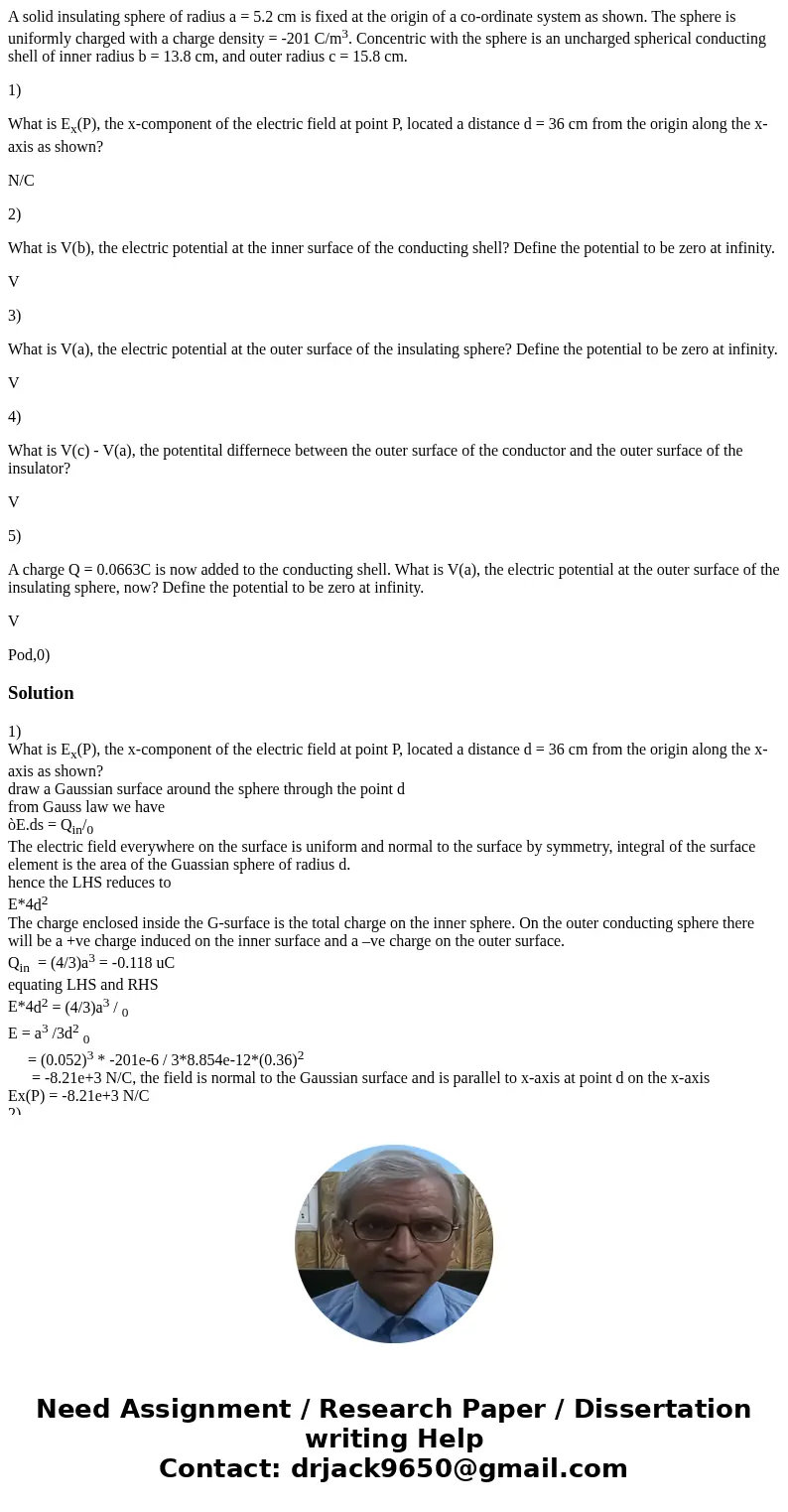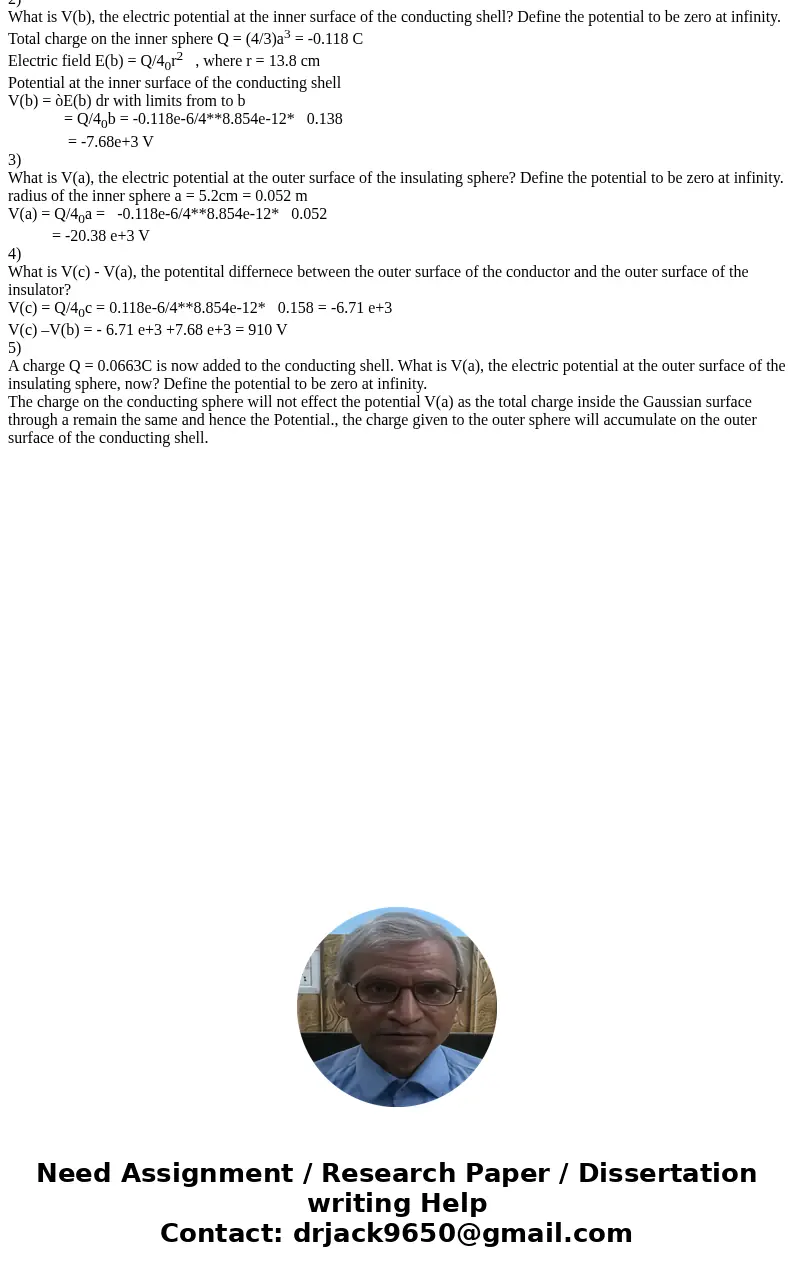A solid insulating sphere of radius a 52 cm is fixed at the
A solid insulating sphere of radius a = 5.2 cm is fixed at the origin of a co-ordinate system as shown. The sphere is uniformly charged with a charge density = -201 C/m3. Concentric with the sphere is an uncharged spherical conducting shell of inner radius b = 13.8 cm, and outer radius c = 15.8 cm.
1)
What is Ex(P), the x-component of the electric field at point P, located a distance d = 36 cm from the origin along the x-axis as shown?
N/C
2)
What is V(b), the electric potential at the inner surface of the conducting shell? Define the potential to be zero at infinity.
V
3)
What is V(a), the electric potential at the outer surface of the insulating sphere? Define the potential to be zero at infinity.
V
4)
What is V(c) - V(a), the potentital differnece between the outer surface of the conductor and the outer surface of the insulator?
V
5)
A charge Q = 0.0663C is now added to the conducting shell. What is V(a), the electric potential at the outer surface of the insulating sphere, now? Define the potential to be zero at infinity.
V
Pod,0)Solution
1)
What is Ex(P), the x-component of the electric field at point P, located a distance d = 36 cm from the origin along the x-axis as shown?
draw a Gaussian surface around the sphere through the point d
from Gauss law we have
òE.ds = Qin/0
The electric field everywhere on the surface is uniform and normal to the surface by symmetry, integral of the surface element is the area of the Guassian sphere of radius d.
hence the LHS reduces to
E*4d2
The charge enclosed inside the G-surface is the total charge on the inner sphere. On the outer conducting sphere there will be a +ve charge induced on the inner surface and a –ve charge on the outer surface.
Qin = (4/3)a3 = -0.118 uC
equating LHS and RHS
E*4d2 = (4/3)a3 / 0
E = a3 /3d2 0
= (0.052)3 * -201e-6 / 3*8.854e-12*(0.36)2
= -8.21e+3 N/C, the field is normal to the Gaussian surface and is parallel to x-axis at point d on the x-axis
Ex(P) = -8.21e+3 N/C
2)
What is V(b), the electric potential at the inner surface of the conducting shell? Define the potential to be zero at infinity.
Total charge on the inner sphere Q = (4/3)a3 = -0.118 C
Electric field E(b) = Q/40r2 , where r = 13.8 cm
Potential at the inner surface of the conducting shell
V(b) = òE(b) dr with limits from to b
= Q/40b = -0.118e-6/4**8.854e-12* 0.138
= -7.68e+3 V
3)
What is V(a), the electric potential at the outer surface of the insulating sphere? Define the potential to be zero at infinity.
radius of the inner sphere a = 5.2cm = 0.052 m
V(a) = Q/40a = -0.118e-6/4**8.854e-12* 0.052
= -20.38 e+3 V
4)
What is V(c) - V(a), the potentital differnece between the outer surface of the conductor and the outer surface of the insulator?
V(c) = Q/40c = 0.118e-6/4**8.854e-12* 0.158 = -6.71 e+3
V(c) –V(b) = - 6.71 e+3 +7.68 e+3 = 910 V
5)
A charge Q = 0.0663C is now added to the conducting shell. What is V(a), the electric potential at the outer surface of the insulating sphere, now? Define the potential to be zero at infinity.
The charge on the conducting sphere will not effect the potential V(a) as the total charge inside the Gaussian surface through a remain the same and hence the Potential., the charge given to the outer sphere will accumulate on the outer surface of the conducting shell.


 Homework Sourse
Homework Sourse